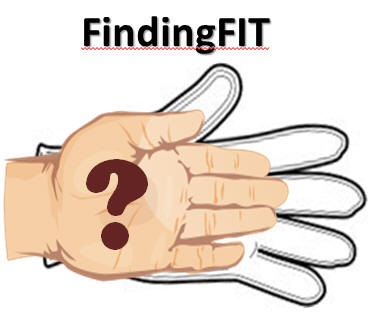
Minimizing the gap between who you are and what you do. <<Back
 |
FindingFIT
Introduction, Fundamentals & Organizing Module Minimizing the gap between who you are and what you do. <<Back |
FindingFIT is a rigorous data-based program for self-assessment and career development. There are four modules to FindingFIT: 1) Introduction, Fundamentals & Organizing, 2) Self-Assessment, 3) Creating Life Themes, and 4) Career Development.
This page is the "Introduction, Fundamentals and Organizing module." The concepts here describe our basic framework, how the process will work, how to organize yourself and what results you can expect.
Think of your self-assessment as a detailed description of your "hand." Your hand profile is unique to you: the shape of your hand, the shape of your fingers, your nails, your palm, your fingerprints, all are unique to you. The FindingFIT self-assessment process will give you strong detail on many dimensions of your personality and behavior.
Then, think of the best job for you as a "glove." If the glove doesn't fit well, you might be able to do things, but with a better fitting glove, you can capitalize on all your personal talents and natural tendencies. If the glove is too large, or to small, or the fingers are too short or too long, if the wrist is too short or too long, all of these things will affect your ability to do your best.
Following this analogy, the two main modules in the FindingFIT model are self-assessment (your hand) and career development (the glove). Our goal is to help you find out, carefully and rigorously, who you are (the hand), and what kind of work you should be seeking (the glove). We don't believe that one size fits all nor that people can do their best by struggling to adapt to ill-fitting gloves. The key issue in making good career decisions is finding a FIT between who you are and what you are doing or being asked to do.
Yes, people can and do adapt, some better than others. Your degree of "adaptability" may be the topic for a pattern in your life. In our experience, a person's ability to adapt is limited. And research shows that people who are engaged in things that they like to do, are good at, and for which there is a financial demand are more successful. So, again, the key to good career decisions is an assessment of the "goodness of fit" between two pieces, who you are and what jobs demand of you.
In the self-assessment module, we will use multiple self-assessment instruments or tools because we believe that no single instrument is accurate enough or comprehensive enough to have complete confidence in. This is a key and central principle of the FindingFIT approach. We will look for patterns that appear across instruments and over time. These enduring patterns we will call "Life Themes."
Program Philosophy
The
FindingFit program is built on several
fundamental assumptions. Please note these carefully.
Key Managerial Skill Building
The FindingFIT process builds some essential managerial skills that go well beyond finding your next job. This is a huge positive side effect of this process.
The Data Generating Process
In the
self-assessment assignments in the Self-Assessment Module, we will use
this repeating process.
Please become familiar with it and use it with each of the
instruments/steps below.
Examples of What the
Final Product Looks Like:
Self-Assessment and Career Development Papers
This link will show you some final papers from the
self-assessment and career development portions of the semester-long
version of the career management course. Here you can see what a
careful, rigorous three month long process can produce. You can
produce the same kind of high quality result if you choose to do so.
Many people will be using these materials under the guidance of an
instructor or counselor. You can do it on your own, though, if you
wish. It's more difficult to do on your own, AND it's your life and your
career, so you can pursue the process as vigorously as you wish. These
examples will give you an idea about what the final products (both
self-assessment and career development plan) could look like.
Organizing Your FindingFIT Data
Throughout the FindingFIT process you will be generating a
lot of data, documents, charts, inferences, spreadsheets, etc.
There are at least three ways you could organize your soon-to-be-growing
piles of data. First, we will introduce to
you a fairly comprehensive Excel spreadsheet, your
Career Option Workbook (or "COW"), in which you can
keep your data and analyses organized all in one file--if that option
appeals to you.
Alternately, you could create a new FindingFit folder on your computer and inside that folder create two new folders titled SELF-ASSESSMENT and CAREER DEVELOPMENT. Then inside the Self-Assessment folder, create new folders for each new instrument that we use.
This folder structure on your computer would look like this:
| FINDING FIT
SELF-ASSESSMENT Instrument #1 Instrument #2 etc. Life Themes or Patterns Implications of Life Themes CAREER DEVELOPMENT Career Objective Resume Professional Portfolio Correspondence Networking etc. |
Thirdly, you may wish to develop a hard-copy three ring binder version of your FindingFIT data and materials. When we taught the course over three months to MBAs, our students would fill a 2 1/2 inch (very large) binder.
So with regard to how you plan to maintain your data, you decide whether you want to focus on the Excel spreadsheet approach, the computer folder/file approach or the hard-copy binder approach.
Okay...with all of these fundamentals in place, let's move onto the Self-Assessment Module. We encourage you to return to this page and review the basics if at any point in the process you feel like you are losing your way.